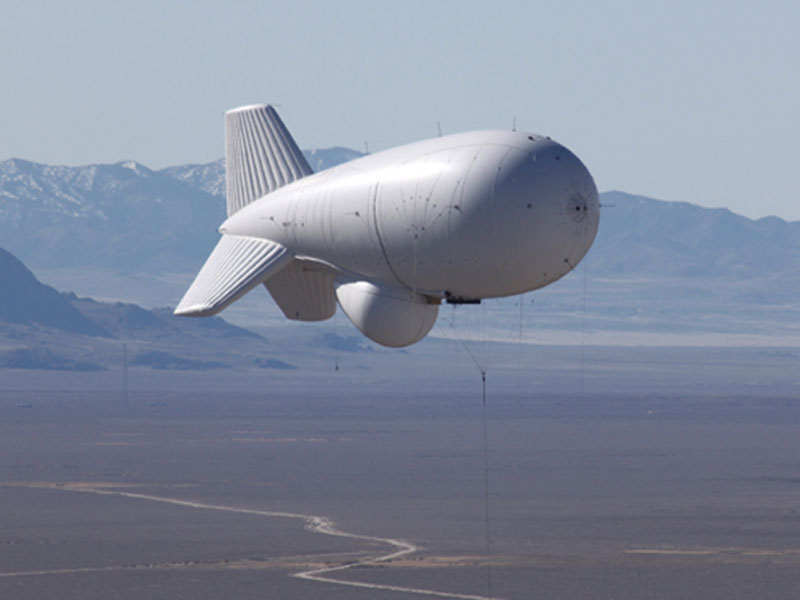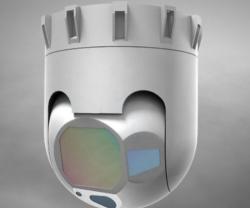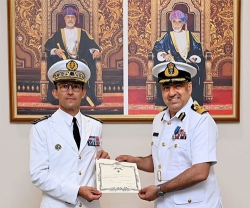JLENS-Guided AMRAAM Intercepts Cruise Missile
13.08.2013 North America
The U.S. Army and U.S. Air Force intercepted for the first time an anti-ship cruise missile surrogate using Raytheon Company's Advanced Medium Range Air-to-Air Missile (AMRAAM) cued by JLENS.
An affordable, elevated, persistent over-the-horizon sensor system, JLENS uses a powerful integrated radar system to detect, track and target a variety of threats.
“Integrating JLENS' precision detection and targeting information with the combat-proven AMRAAM gives our military a new way to defend the fleet and our allies from anti-ship cruise missiles that threaten vital waterways and critical chokepoints,” said Dave Gulla, Vice President of Global Integrated Sensors for Raytheon's Integrated Defense Systems business.
During the July 17 test, the Army's JLENS acquired and tracked an anti-ship cruise missile surrogate and passed targeting data to an Air Force F-15E via Link 16, enabling the fighter pilot to fire an AIM-120C7 AMRAAM, culminating in the weapon intercepting the target, meeting all test objectives.
“JLENS has proven it can defend and extend the battlespace by integrating with Patriot, Standard Missile-6, and now AMRAAM. This test enhances the cruise missile defense umbrella, and when this capability is deployed, it will help save lives,” said Dean Barten, the U.S. Army's JLENS Product Manager.
“Integrating AMRAAM with JLENS enables the world's most capable air-to-air missile to engage targets at the weapon's maximum kinematic range,” said Harry Schulte, Vice President of Raytheon Missile Systems' Air Warfare Systems.
“This test further demonstrates AMRAAM's operational flexibility and provides today's warfighter with enhanced operational capability, cost effectiveness and future growth solutions,” he added.
JLENS (photo) consists of an integrated surveillance and fire-control radar on two tethered, 74-meter aerostats, which fly at altitudes of 10,000 feet above sea level and remain aloft and operational for 30 days. This capability better enables commanders to defend against threats including hostile cruise missiles, low-flying manned and unmanned aircraft, and moving surface vehicles such as boats, mobile missile launchers, automobiles, trucks and tanks. JLENS also provides ascent phase detection of tactical ballistic missiles and large-caliber rockets.
AMRAAM is a combat-proven missile that has demonstrated operational flexibility in both air-to-air and surface-launch engagement scenarios and provides today's warfighter with enhanced operational capability, cost effectiveness and future growth options and solutions. Procured by 36 countries, the combat-proven AMRAAM has been operational and integrated on the F-16, F-15, F/A-18, F-22, Typhoon, Gripen, Tornado, Harrier and F-4, and integration is ongoing in the Joint Strike Fighter aircraft. It is also the baseline missile for the NATO-approved National Advanced Surface-to-Air Missile System.
An affordable, elevated, persistent over-the-horizon sensor system, JLENS uses a powerful integrated radar system to detect, track and target a variety of threats.
“Integrating JLENS' precision detection and targeting information with the combat-proven AMRAAM gives our military a new way to defend the fleet and our allies from anti-ship cruise missiles that threaten vital waterways and critical chokepoints,” said Dave Gulla, Vice President of Global Integrated Sensors for Raytheon's Integrated Defense Systems business.
During the July 17 test, the Army's JLENS acquired and tracked an anti-ship cruise missile surrogate and passed targeting data to an Air Force F-15E via Link 16, enabling the fighter pilot to fire an AIM-120C7 AMRAAM, culminating in the weapon intercepting the target, meeting all test objectives.
“JLENS has proven it can defend and extend the battlespace by integrating with Patriot, Standard Missile-6, and now AMRAAM. This test enhances the cruise missile defense umbrella, and when this capability is deployed, it will help save lives,” said Dean Barten, the U.S. Army's JLENS Product Manager.
“Integrating AMRAAM with JLENS enables the world's most capable air-to-air missile to engage targets at the weapon's maximum kinematic range,” said Harry Schulte, Vice President of Raytheon Missile Systems' Air Warfare Systems.
“This test further demonstrates AMRAAM's operational flexibility and provides today's warfighter with enhanced operational capability, cost effectiveness and future growth solutions,” he added.
JLENS (photo) consists of an integrated surveillance and fire-control radar on two tethered, 74-meter aerostats, which fly at altitudes of 10,000 feet above sea level and remain aloft and operational for 30 days. This capability better enables commanders to defend against threats including hostile cruise missiles, low-flying manned and unmanned aircraft, and moving surface vehicles such as boats, mobile missile launchers, automobiles, trucks and tanks. JLENS also provides ascent phase detection of tactical ballistic missiles and large-caliber rockets.
AMRAAM is a combat-proven missile that has demonstrated operational flexibility in both air-to-air and surface-launch engagement scenarios and provides today's warfighter with enhanced operational capability, cost effectiveness and future growth options and solutions. Procured by 36 countries, the combat-proven AMRAAM has been operational and integrated on the F-16, F-15, F/A-18, F-22, Typhoon, Gripen, Tornado, Harrier and F-4, and integration is ongoing in the Joint Strike Fighter aircraft. It is also the baseline missile for the NATO-approved National Advanced Surface-to-Air Missile System.
Previous PostHarris Wins NETCENTS-2 Application Services Order
Latest news
Latest events
Paris Air Show
16 - 22 Jun 2025Paris Le Bourget - FranceDefenPol China2025 - 7th Guangzhou International Defense & Police Exhibition & Summit
11 - 12 Jul 2025Nan Fung International Convention & Exhibition Center (NICEC) - ChinaIDEF 2025 Turkey - International Defence Industry Fair
22 - 27 Jul 2025Istanbul Expo Center - TurkeyDSEI 2025
09 - 12 Sep 2025Excel, London - United Kingdom






















